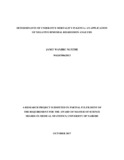| dc.contributor.author | Ng’ethe, Janet W | |
| dc.date.accessioned | 2018-02-01T08:44:34Z | |
| dc.date.available | 2018-02-01T08:44:34Z | |
| dc.date.issued | 2017 | |
| dc.identifier.uri | http://hdl.handle.net/11295/103114 | |
| dc.description.abstract | Introduction: Under-five mortality is a key indicator of the state of public health of a society. Globally, approximately six million children die every year before reaching their fifth birthday. Although the global under-five mortality rate declined by 53 percent between 1990 and 2015, the under-five mortality in Kenya remains high in spite of government efforts to reduce its burden and currently stands at 52 deaths per 1000 live births.
Objective: The main objective of this study was to determine the factors influencing under-five mortality in Kenya.
Methodology: The study involved analysis of secondary data from a population based cross sectional survey, the 2014 KDHS. The population of interest were the mothers who were age 15-49 years and had given birth in the five-year period preceding the survey. The software used in data management and analysis was STATA software version 12. Descriptive statistics including frequencies and tabulations provided an overall picture of the distribution of the number of under-five deaths. The negative binomial regression model was used to evaluate the influence of selected determinants on under-five mortality.
Results: 15,755 women who had at least given birth to a singleton in the five years preceding the survey were included in the final analysis. The mean age of the women was 29.12 years (SD=6.88). Women living in rural areas had a 13% reduced risk of having a child die before their fifth birthday (IRR; 0.87, 95% CI; 0.74-1.02). Each additional child born with a preceding birth interval of less than 24 months increased the risk of the mother losing the child through death before the attainment of their fifth birthday by 2.41 times (IRR; 2.41, 95% CI; 2.23-2.60). Every additional child delivered when the mother was either less than 18 years or above 35 years old, increased the risk of the mother losing a child by 17% (IRR ;1.17, 95% CI; 1.06-1.29). The women who had given birth to five children or more at the time of the interview had a 26% (IRR 1.26, 95% CI; 1.08-1.46) higher risk of losing a child before attainment of their fifth birthday compared to those who had given birth to less than five children.
Conclusion: Preceding birth interval, parity and maternal age at birth are key determinants of under-five mortality in Kenya. Educating the public on family planning will improve child survival | en_US |
| dc.language.iso | en | en_US |
| dc.publisher | University of Nairobi | en_US |
| dc.rights | Attribution-NonCommercial-NoDerivs 3.0 United States | * |
| dc.rights.uri | http://creativecommons.org/licenses/by-nc-nd/3.0/us/ | * |
| dc.title | Determinants of under-five mortality in Kenya: an application of Negative Binomial Regression analysis. | en_US |
| dc.type | Thesis | en_US |
| dc.description.department | a
Department of Psychiatry, University of Nairobi, ; bDepartment of Mental Health, School of Medicine,
Moi University, Eldoret, Kenya | |



